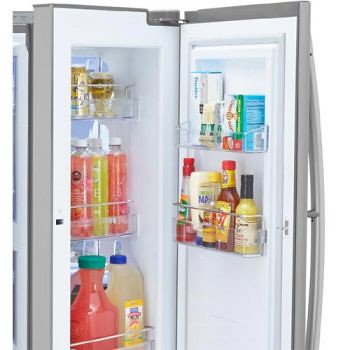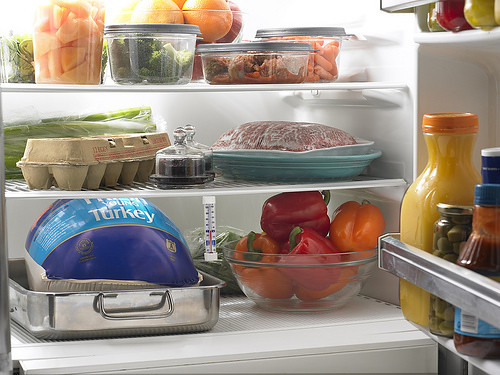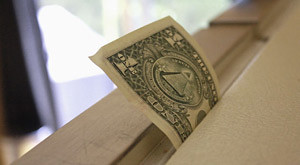A lot of families think of the hulking metal box in the kitchen as "the Amana gallery" or a message center for Post-Its®, but in reality the refrigerator is one of your home's biggest consumers of electricity. The U.S. Department of Energy says that an average 16-cubic foot frost-free refrigerator, a medium-sized model, draws about 725 watts of electricity 24/7. That's about six times the power draw of a flat-screen TV, or seventy-two times the energy consumption of a clock radio. It should be clear that your refrigerator has the potential to be wasting energy -- a lot of energy. Fortunately, there are ways to reduce your fridge's appetite for power.
Those loopy-looking metal coils on the back of your fridge are part of the way the device "sucks the heat" out of the food compartment. As a liquid refrigerant circulates through the coils, it radiates heat into the air around them. A coating of dust and pet hair will act like insulation, making this process of heat exchange less efficient, thereby consuming more energy. Owners can reduce wasted energy by regularly pulling the fridge out from the wall and vacuuming the coils to remove the dust.
 A refrigerator is most efficient when it's nearly full but its contents allow plenty of air circulation. Many refrigerators cool the food compartment with air circulated from the freezer compartment, especially top-freezer models. Overcrowding the shelves can reduce air circulation, creating pockets of cold and warm air. You can improve air circulation and energy efficiency by not overpacking the shelves. Placing tall items too close to air vents can also block cold air that's supposed to leak in from the freezer.
A refrigerator is most efficient when it's nearly full but its contents allow plenty of air circulation. Many refrigerators cool the food compartment with air circulated from the freezer compartment, especially top-freezer models. Overcrowding the shelves can reduce air circulation, creating pockets of cold and warm air. You can improve air circulation and energy efficiency by not overpacking the shelves. Placing tall items too close to air vents can also block cold air that's supposed to leak in from the freezer.
It may not seem particularly intuitive, but an empty fridge is less efficient than a full one. It takes more energy to keep the chilling air that enters the fridge every time you or the kids open the door than it does to keep solid contents cold. If your fridge is mostly empty, it can make sense to fill an unused shelf with milk jugs of water or even use large blocks of plastic foam to fill up the empty space. Just make sure that you leave plenty of space between your "fake food" so the air can circulate freely. This also works in the freezer compartment.
Remember Dad asking if you were trying to heat the whole outdoors when you left the front door open? Well, a refrigerator will happily try to chill the entire kitchen if the door doesn't close all the way or if the rubber gasket has become leaky. If you can feel cold air on your toes even when the door is closed, you might have a problem. Check first to see if the door is being propped open by something in the contents or by the crisper drawer. If the door is fully closed, try the money test: close the door on a dollar bill at several different places and see if you can easily pull it out. If the bill slips out easily, the gasket is loose and needs attention. Sometimes it can be cleaned, but you may need to replace a deteriorated gasket.
When buying a new fridge, consider your needs. Buy a refrigerator that fits your lifestyle and your family, as well as one that fits your kitchen. Look for those yellow "Energy Smart™" labels on a new refrigerator, and factor energy usage into your buying decision. Do some household math: if you pay 10 cents per KWH (kilowatt hour) for your electricity, a refrigerator that uses 100 watts less energy can save you 24 cents per day, or more than $91 per year. Over ten years, that works out to more than $900 in savings!
Keep it Clean
Those loopy-looking metal coils on the back of your fridge are part of the way the device "sucks the heat" out of the food compartment. As a liquid refrigerant circulates through the coils, it radiates heat into the air around them. A coating of dust and pet hair will act like insulation, making this process of heat exchange less efficient, thereby consuming more energy. Owners can reduce wasted energy by regularly pulling the fridge out from the wall and vacuuming the coils to remove the dust.
Keep it Cool, Not ColdBuy an inexpensive appliance thermometer to check the temperature of the food compartment, and adjust the temperature to keep it in the range of about 37 to 40 degrees F (2.7 - 4.4 degrees C). The freezer compartment should be kept at 5 degrees F (-15 degrees C). Allow twenty-four hours after adjusting the controls before taking the next temperature measurement. It's also a good idea to take the temperature at several places in the food compartment. The warmest places are on and near the door and the coldest spots are at the back and on the lowest shelf. |
Fill it Efficiently
 A refrigerator is most efficient when it's nearly full but its contents allow plenty of air circulation. Many refrigerators cool the food compartment with air circulated from the freezer compartment, especially top-freezer models. Overcrowding the shelves can reduce air circulation, creating pockets of cold and warm air. You can improve air circulation and energy efficiency by not overpacking the shelves. Placing tall items too close to air vents can also block cold air that's supposed to leak in from the freezer.
A refrigerator is most efficient when it's nearly full but its contents allow plenty of air circulation. Many refrigerators cool the food compartment with air circulated from the freezer compartment, especially top-freezer models. Overcrowding the shelves can reduce air circulation, creating pockets of cold and warm air. You can improve air circulation and energy efficiency by not overpacking the shelves. Placing tall items too close to air vents can also block cold air that's supposed to leak in from the freezer.Fill it Full
It may not seem particularly intuitive, but an empty fridge is less efficient than a full one. It takes more energy to keep the chilling air that enters the fridge every time you or the kids open the door than it does to keep solid contents cold. If your fridge is mostly empty, it can make sense to fill an unused shelf with milk jugs of water or even use large blocks of plastic foam to fill up the empty space. Just make sure that you leave plenty of space between your "fake food" so the air can circulate freely. This also works in the freezer compartment.
Check the Door
Remember Dad asking if you were trying to heat the whole outdoors when you left the front door open? Well, a refrigerator will happily try to chill the entire kitchen if the door doesn't close all the way or if the rubber gasket has become leaky. If you can feel cold air on your toes even when the door is closed, you might have a problem. Check first to see if the door is being propped open by something in the contents or by the crisper drawer. If the door is fully closed, try the money test: close the door on a dollar bill at several different places and see if you can easily pull it out. If the bill slips out easily, the gasket is loose and needs attention. Sometimes it can be cleaned, but you may need to replace a deteriorated gasket.
Buy Right
When buying a new fridge, consider your needs. Buy a refrigerator that fits your lifestyle and your family, as well as one that fits your kitchen. Look for those yellow "Energy Smart™" labels on a new refrigerator, and factor energy usage into your buying decision. Do some household math: if you pay 10 cents per KWH (kilowatt hour) for your electricity, a refrigerator that uses 100 watts less energy can save you 24 cents per day, or more than $91 per year. Over ten years, that works out to more than $900 in savings!
| It doesn't take a great deal of effort to tame the appetite of your power-hungry appliance. You can slim your electricity hog down by cleaning it regularly, maintaining the correct temperature and paying attention to how you arrange its contents. Now there's a painless way to save a few dollars on your electric bill! |
copyright © 2016-2022 scmrak



No comments:
Post a Comment